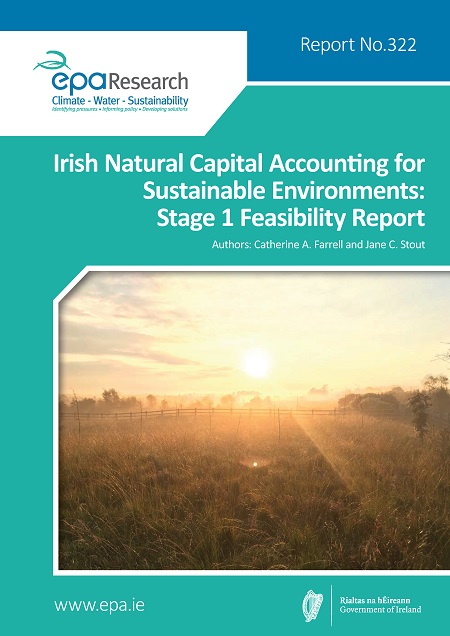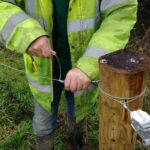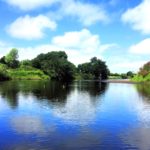In December 2018 there was a major fish kill on…
Irish Natural Capital Accounting for Sustainable Environments (INCASE)
Catherine Farrell is a researcher with INCASE, an EPA-funded research project that is piloting environmental accounts for four catchments in Ireland. Catherine tells us about the use of natural capital accounting in Ireland, the policy drivers, the role of the United Nations System of Environmental-Economic Accounting (SEEA) in this, and a little about the four catchments chosen for this pilot…
“The biodiversity convention’s member states have to publish biodiversity action plans — but these are often statements of a country’s ambitions, rather than records of its achievements. For the next set of goals this has to change, and fortunately there seems to be a way forward. This is the UN System of Environmental Economic Accounting (SEEA), a mechanism for reporting environmental data, and it needs to become the global standard for environmental reporting”
Nature Editorial, 18 February 2020
Can natural capital accounting be used in Ireland?
The natural world we live in underpins human existence. It can be thought of as our stock of natural capital that yields flows of goods and services. These goods and services include the basic requirements of daily living – food, water, clean air, etc. Ensuring those services continue to flow for this generation and future generations is one of the fundamental aspects of sustainable development and the keystone of social and economic welfare.
In the Irish context, the EPA State of the Environment Report (EPA State of the Environment Report 2016) highlights the need to integrate natural capital accounting (NCA, often referred to as Green or Environmental Accounting) into our measures of prosperity, so that we can track and measure our performance alongside related issues such as wellbeing and environmental health.
NCA can be used to identify trends in the quality of the environment, inform trade-offs, identify co-benefits, establish critical links between natural and other capitals (such as built and social capital) as well as identifying knowledge gaps. Such an approach will help us to understand and, combined with the use of other appropriate tools, address the dominant pressures and their impacts – climate change, growth in human population, continued degradation of nature – on Ireland’s environment.
The INCASE (Irish Natural Capital Accounting for Sustainable Environments) research project aims to apply NCA at a pilot (catchment) scale in Ireland. Significant pressures on At Risk water bodies are well-defined at catchment level by the EPA, with agriculture identified as the most significant pressure in the River Basin Management Plans 2018-2021. In the meantime, EPA reports in December 2019 indicate that water quality in Ireland continues to decline. Addressing the causes or drivers of these pressures can help to identify solutions to reverse negative trends.
Developing natural capital accounts at catchment scale will inform how the accounts (asset extent, condition, supply and use of services, benefits, etc) can be built using Irish data sources and provide valuable lessons on how best to scale up to the national level. INCASE will explore how NCA can be used to identify solutions either through investing in and renewing degraded natural capital stocks and flows (improving water quality, restoring ecosystems, etc) and/or changing management practices and incentive schemes (for example developing Payment for Ecosystem Services).

What are the policy drivers for Natural Capital Accounting?
As with many aspects of humanity, it is the policy instruments at government level (local, regional and international) that dictate where we focus our energy and resources, and this is the same for how and why we must begin taking nature into account. Or put another way, this is why we are developing natural capital accounting (NCA) as a tool to integrate decision making and make better decisions around our use of nature to achieve sustainable development.
Firstly, let us consider how we have fared by not taking nature into account in decision-making. By ignoring nature, widespread ecological degradation continues which in turn leads to local and global critical levels of biodiversity loss. Biodiversity underpins natural capital, and degradation of natural capital has led to global pressures such as climate change. We are now faced with ongoing and repeated calls for transformative changes in human behaviour to prevent further degradation beyond critical thresholds, as highlighted in the IPBES 2019 and IPCC 2019 reports. Changing behaviour is difficult and this is where the policy comes in – to help focus our energy around making those changes.
In response to these pressures, UN policy at international level is calling for wise use of nature. This requires us to develop NCA systems whereby we can track changes in the extent and condition of stocks of natural systems, understand and measure how the services we need, and use are flowing, and what we must do to ensure that flow continues. The call at UN level call is echoed by the new European Green Deal, published at the end of 2019, the recent EU Biodiversity Strategy 2030: Bringing nature back into our lives as well as the 2020 targets for natural capital accounting set in Ireland’s National Biodiversity Plan 2017-2021 and the call for an integrated approach to land-use as set out in the Irish Climate Action Plan, published in 2019.
NCA will be mandatory in coming years and building the best approach and fit for the local, Irish context is essential. The INCASE Project forms part of the network of EU and global projects working towards refinement and further development of NCA methods. As part of this network, Ireland will be well-placed to contribute to and lead in terms of the refinement of the process at national and EU levels.
The role of the System of Environmental Economic Accounting (SEEA) method globally and the steps to its preliminary application in Ireland
The main method of NCA adopted globally, is the System of Environmental-Economic Accounting or SEEA method. This is an emerging statistical system that brings together economic and environmental information into a common framework to measure the contribution of the environment to the economy, and the impact of the economy on the environment.
The SEEA contains an internationally agreed set of standard concepts, definitions, classifications, accounting rules and tables to produce internationally comparable statistics. The SEEA has three components –
- The SEEA Central Framework (2012), which was adopted by the UN Statistical Commission as the first international standard for environmental-economic accounting in 2012
- The SEEA Experimental Ecosystem Accounting, which offers a synthesis of current knowledge in ecosystem accounting
- The SEEA Applications and Extensions, which illustrates to compilers and users of SEEA Central Framework based accounts how the information can be used in decision making, policy review and formulation, analysis and research
Presently more than 80 countries worldwide have adopted the SEEA approach, with the SEEA-CF (Central Framework) in mainstream use and SEEA-EEA (Experimental Ecosystem Accounting) gathering wider use as the method is refined and becomes normalised.
In the EU, NCA has been well-developed in the UK and the Netherlands in the period 2010-2020, with work progressing under the EU KIP-INCA, MAES and MAIA (Mapping and Assessment for Integrated ecosystem Accounting) projects. INCASE will link in with this network of EU projects to assist in developing clear and relevant approaches across the EU.
Ireland has taken preliminary steps. The INCASE Project will build on the work carried out on aspects of NCA and related topics to date in Ireland, bringing it together under the NCA framework, using the SEEA methodology. This will help to develop the best way forward for NCA in Ireland, and therefore avoid ad hoc staggered steps which may otherwise be unproductive. The SEEA-EEA will be extended to account for ecosystems, geosystems and atmospheric systems, testing the approach in four catchments before scaling up to national level. Essentially INCASE will serve to trouble shoot the approach at pilot scale while also determining the most effective and efficient way to classify assets, measure condition, identify flows of services and identify benefits and beneficiaries.
The work to date by the INCASE Project Team has established that developing natural capital accounts at catchment and national scale is feasible. Critical steps include a review and assessment of the wide array and quality of data available in terms of outlining the basic requirements for NCA in Ireland and potential data gaps. Establishing the process steps to gather, collate, assess and align these data in a standardised way is a key output of INCASE. Determining how available data can be used for various accounts will follow from the data review.
The outputs will inform national scale application and has already created a discussion platform around challenges in terms of highlevel concepts about NCA: how can it align with (replace?) GDP to develop truer reflections of prosperity, how to progress on valuation, the efficacy of the approach in general and basic aspects such as data share and data quality.
How will INCASE use the System of Environmental Economic Accounting to aid assessment, reporting and improvement of water quality in our catchments?
While Natural Capital Accounting has a range of potential uses and applications, the central focus of INCASE is to inform how NCA (specifically the SEEA approach), can assist with reporting and/or working towards water protection and management in the context of implementation of the Water Framework Directive River Basin Management Plan (RBMP) for Ireland in the period 2022-2027.
INCASE will link the NCA approach with the Integrated Catchment Management (ICM) approach already in use in RBMPs. ICM was originally developed as the approach in Ireland for water management as awareness grew of the connectedness of our natural environment (water, habitats, soils, GHG emissions) and of the co-benefits of considering all natural systems (eco-, geo- , atmospheric systems) together as a broader interconnected system. Thus, highlighting that catchments are landscape units where these systems align. Linking NCA with ICM, thereby broadens the perspective of ICM as used and promoted by the EPA Catchments Unit, bringing focus to the dependencies between land use planning and environmental management in general. Working with key stakeholders like the CSO and NPWS, INCASE will explore how the stocks and flows in each catchment relate to society.

The work is pioneering, and over the course of the next couple of years we will streamline the process of applying the SEEA framework, so that it can be extended nationally. Key outcomes will be identifying critical data sets and standardising the approach in the Irish context.
Four catchment areas have been selected for INCASE, representing a range of conditions and characteristics.
- The Caragh sub-catchment in West Kerry is predominantly a peatland catchment with considerable data already gathered by KerryLIFE and the Pearl Mussel Project
- The Dargle in Wicklow has similar features, but it is also an extension of our capital city Dublin with an expanding urban population in a coastal context
- The Bride in Cork is a pastoral farming catchment with another EIP ongoing – the BRIDE regenerative farming project
- In complete contrast, the Figile River (two sub-catchments combined at the headwaters of the River Barrow) in the industrial peatland landscape of East Offaly has a number of challenges in relation to peatland management and water quality
Catherine Farrell, INCASE Project
Learn more:
The INCASE Team: we are a multi-disciplinary team with specialists in ecology, freshwater biology, economics, statistics, accounting and agriculture – Professor Jane Stout, Trinity College Dublin; Prof Cathal O’Donoghue, NUI Galway; Mark Eigenraam, Ideea Group; Assoc. Prof Stephen Kinsella, University of Limerick; Assoc. Prof Mary Kelly-Quinn, University College Dublin; Orlaith Delargy, IFNC; Carl Obst, IDEEA Group; Dr Catherine Farrell, Trinity College Dublin; Lisa Coleman, University College Dublin.







